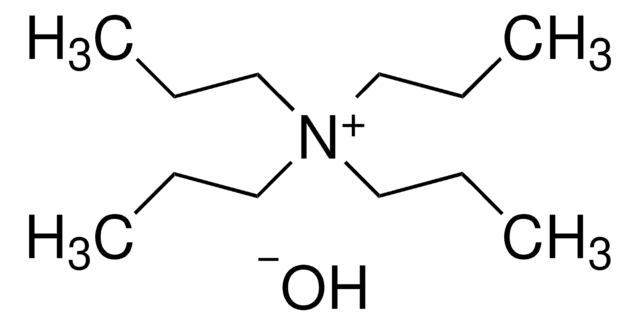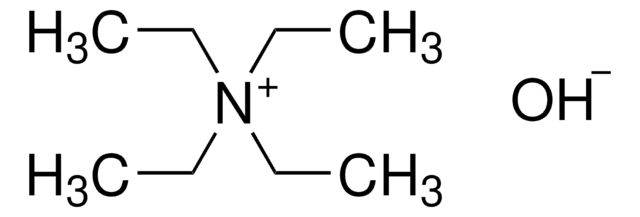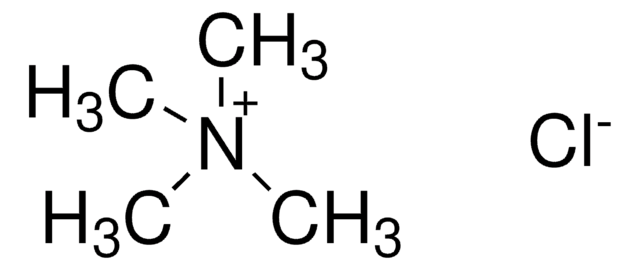Wszystkie zdjęcia(2)
Key Documents
88005
Tetrapentylammonium hydroxide solution
~20% in H2O (T)
Zaloguj sięWyświetlanie cen organizacyjnych i kontraktowych
About This Item
Wzór liniowy:
[CH3(CH2)4]4N(OH)
Numer CAS:
Masa cząsteczkowa:
315.58
Beilstein:
6785584
Numer MDL:
Kod UNSPSC:
12352106
Identyfikator substancji w PubChem:
NACRES:
NA.22
Polecane produkty
Postać
solution
stężenie
~20% in H2O (T)
zanieczyszczenia
≤0.05% halides (as bromide)
ślady anionów
sulfate (SO42-): ≤500 mg/kg
grupa funkcyjna
amine
ciąg SMILES
[OH-].CCCCC[N+](CCCCC)(CCCCC)CCCCC
InChI
1S/C20H44N.H2O/c1-5-9-13-17-21(18-14-10-6-2,19-15-11-7-3)20-16-12-8-4;/h5-20H2,1-4H3;1H2/q+1;/p-1
Klucz InChI
JVOPCCBEQRRLOJ-UHFFFAOYSA-M
Powiązane kategorie
Zastosowanie
Tetrapentylammonium hydroxide can be used:
- As a model compound in the studies of the effects of quaternary ammonium salts on the formation of clathrate hydrates of methane.
- To maintain the pH of the aqueous phase to study the adsorption dynamics of nanoparticles at fluid interfaces.
This page may contain text that has been machine translated.
Hasło ostrzegawcze
Danger
Zwroty wskazujące rodzaj zagrożenia
Zwroty wskazujące środki ostrożności
Klasyfikacja zagrożeń
Skin Corr. 1B
Kod klasy składowania
8A - Combustible corrosive hazardous materials
Klasa zagrożenia wodnego (WGK)
WGK 3
Temperatura zapłonu (°F)
Not applicable
Temperatura zapłonu (°C)
Not applicable
Środki ochrony indywidualnej
Faceshields, Gloves, Goggles, type ABEK (EN14387) respirator filter
Wybierz jedną z najnowszych wersji:
Masz już ten produkt?
Dokumenty związane z niedawno zakupionymi produktami zostały zamieszczone w Bibliotece dokumentów.
Klienci oglądali również te produkty
Semiclathrate hydrates of methane+ tetraalkylammonium hydroxides
Su Y, et al.
Fuel: The Science and Technology of Fuel and Energy, 203, 618-626 (2017)
Xiaoqing Hua et al.
Soft matter, 14(19), 3818-3828 (2018-05-03)
Understanding the dynamic adsorption of nanoparticles (NPs) at fluid interfaces is important for stabilizing emulsions and for the preparation of 2D NP-based materials. Here we show that the Ward-Tordai equations commonly employed to describe the dynamics of surfactant adsorption at
Xiaoqing Hua et al.
Langmuir : the ACS journal of surfaces and colloids, 34(16), 4830-4842 (2018-04-11)
Nanoparticles (NPs) can add functionality (e.g., catalytic, optical, rheological) to an oil-water interface. Adsorption of ∼10 nm NPs can be reversible; however, the mechanisms for adsorption and its effects on surface pressure remain poorly understood. Here we demonstrate how the
Roger C Lo et al.
Bioanalysis, 4(6), 693-701 (2012-03-29)
Different markers have been used to label DNA for sample detection in gel electrophoresis. Intercalating dyes, (e.g., YOYO) have been widely used to label DNA for sample detection, because they do not require the use of radioisotopes, covalent attachment or
Nishant Chetwani et al.
Analytical chemistry, 83(8), 3017-3023 (2011-03-23)
The novel effects resulting from the entrainment of low mobility ions during alternating current (ac) electrospray ionization are examined through mass spectrometry and voltage/current measurements. Curious phenomena such as pH modulation at high frequencies (>150 kHz) of an applied ac
Nasz zespół naukowców ma doświadczenie we wszystkich obszarach badań, w tym w naukach przyrodniczych, materiałoznawstwie, syntezie chemicznej, chromatografii, analityce i wielu innych dziedzinach.
Skontaktuj się z zespołem ds. pomocy technicznej









